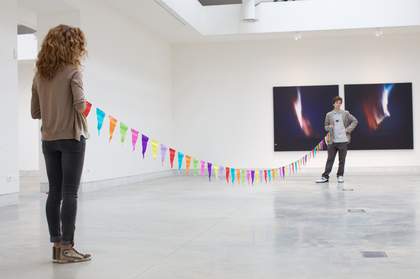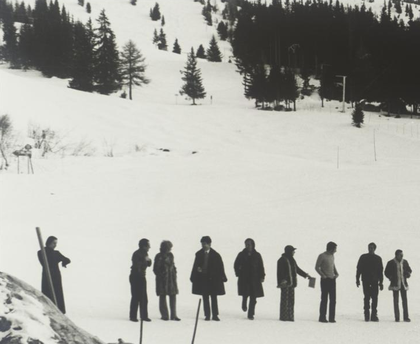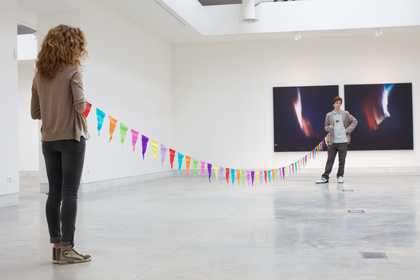
Amalia Pica
Strangers 2008
Photo © Tate
The Performance Specification consists of a single central written document that captures written information about performance-based artwork. It contains seven overall category headings: ‘Artwork Requirements’, ‘Space’, ‘Time’, ‘Audience/Viewers’, ‘Performer’, ‘Physical Components’, ‘Logistics’, with two further categories: ‘Material Histories’ being captured in a separate document and ‘Activations after Acquisition’ being documented in individual folders for each instantiation of the work, saved in our artwork folder structure under ‘Display History’.
The Performance Specification is a template that was developed from The Live List, an output from the Collecting the Performative project.
The Live List identified information to gather in terms of:
- How to understand and agree the basic parameters of the work
- The relationship with the museum/gallery
- The production of the performance
- Documentation
- Audience
The Performance Specification developed the above headings and questions. It introduced a range of thematic sections, with key prompting questions that would allow someone to consider and reflect on what might be essential to capture for each performance artwork. The performance specification template aims to expand or contract to suit the artwork being documented. The specification contains both specific questions to be answered alongside a broad menu of aspects to consider when documenting each performance. Rather than answering each question under each section, it is essential to consider what areas are relevant and what questions under each section are then applicable. Not all will be. There may be instances where there isn’t the correct section or perhaps the right questions, this should be reviewed, and amendments made to both the specification and strategy. Specific questions under different sections may illicit a repetition in answer. In this case, it can be decided where the information is most pertinent to supporting a future activation and included there.
Although each artwork has a different relationship to these sections, these were all shared facets and elements of the works. Each artwork exists within a space and has a relationship with that space, whether deliberate on the part of the artist or consequential of curatorial choices, and information about that relationship might support curatorial decision-making for future performance activations. For each of the nine overarching themes, questions are posed to allow the specificities of the individual artworks to be drawn out, potentially allowing for future comparisons between artworks and their relationships to space, but in the immediate sense to identify information vital to the future activations of the work. The overall intention of this stratification at the point of first use is to make the information easily translated and easily accessible. The specification ultimately works as one narrative (even though split into sections), which covers all aspects of the performance; details about the work can be pulled from it or a fuller, overall understanding of the artwork can be gained. Additionally, the specification is considered a working document, which answers to the changes prompted by artworks as they live and thrive through their activation, and recorded in Activation Reports.
The Seven Sections within the Performance Specification
- Artwork Requirements: The Performance Specification template starts with ‘Artwork Requirements’ so that anyone looking at the document is aware of what it takes to activate the artwork in a given space. This section aims to clearly articulate the constant elements that must exist for any activation. Alongside this it is equally important to draw to attention flux elements so the flexibility within the performance is understood. It will reflect the specific conditions, if there are any, the artist has put on their work, and this will negate – as far as is possible to predict – issues around change and variability in the work in the future.
- Space: As there is a variable element of all performance artworks, in terms of both the amount of space needed for an artwork and the type of space (public, gallery, studio) this section aims to understand the space. Because some performance works require an element of movement, the space of the work may not be fixed. So the ability to select areas into which the work can be put is crucial, as is the ability to designate multiple appropriate spaces for the work to move into.
- Time/Duration: Time – in terms of the ‘moment’ of a performance – is a defining element of a work and, like space, is variable across the medium but also within individual artworks. Both the duration and repetition patterns of an artwork need to be noted, as does the flexibility within both elements.
- Performers: Understanding the requirements for those performing the work is vital for ensuring the work is effectively activated. Noting physical needs provides not only that the aesthetic, social or political context of the work are taken into consideration, but also that the performers themselves are able to physically undertake the work for the set duration of the performance. The information recorded here is both about the needs of the artwork and of the performers; support from Human Resources and Visitor Services may help in gathering more information around performer’s rights and needs.
- Physical Components: In some cases, other than the performers, there will be no physical component of a performance artwork either during or after the performance moment. However, there may be artwork components which support the work and/or objects which are created during the activation. As with other material artworks, the requirements for these objects, in their creation, conservation and continued existence in the institution, needs to be recorded accurately. This section would also indicate if special attention from conservators working directly on the physical components of the work is required when the performance is flagged for display or loan-out.
- Audience and Viewer: As with some other types of artwork, viewers of the performance-based artwork can often find themselves taking on the role of a participant or a performer. Understanding the behaviours needed from the audience and anticipating how these may or may not be met by visitors to the institution, will help those in the space – performers or Visitor Experience staff – to manage this. This is also an issue of health and safety, particularly around certain artworks which might involve the participation of a mass group of spectators. Here, observations about previous activations may help to anticipate the response of viewers to the work, which may be beneficial if this is likely to be disruptive or otherwise unpredictable.
- Logistics: There are a considerable number of people involved in activation of a performance work, each with roles which might also fall outside of the norms of the institution (for example, production and casting). Collecting information which already exists about costs, time commitments (internal and external) and who should be involved in a performance will allow this to be done effectively and efficiently and allow the resources necessary to be allocated in advance. If targeted risk assessments are needed, they would usually be linked to this section.
The Performance Specification is complemented by one document on the material history of the artwork before being acquired by Tate, stored under ‘Examination‘, and a series of files on each activation of the artwork after its accessioning, held under ‘Display History‘ in our current Artwork Folder Structure:
- Material History: A history of the work prior to its acquisition into Tate. This collation provides a history of the work before it enters the collection, but it also provides an insight in the variations across the constant or flux that have appeared within the artwork. You may also be able to link key changes to specific moments in time and what prompted this change.
- Activations after Acquisition: These are all display histories from the point the work has entered the collection. This is captured within the display history for the artwork and aims to provide insight over time the variations across the flux aspects or if changes in the constant aspects take place and the rationale for this. One of the key documents for recording these changes is the Activation Report.


